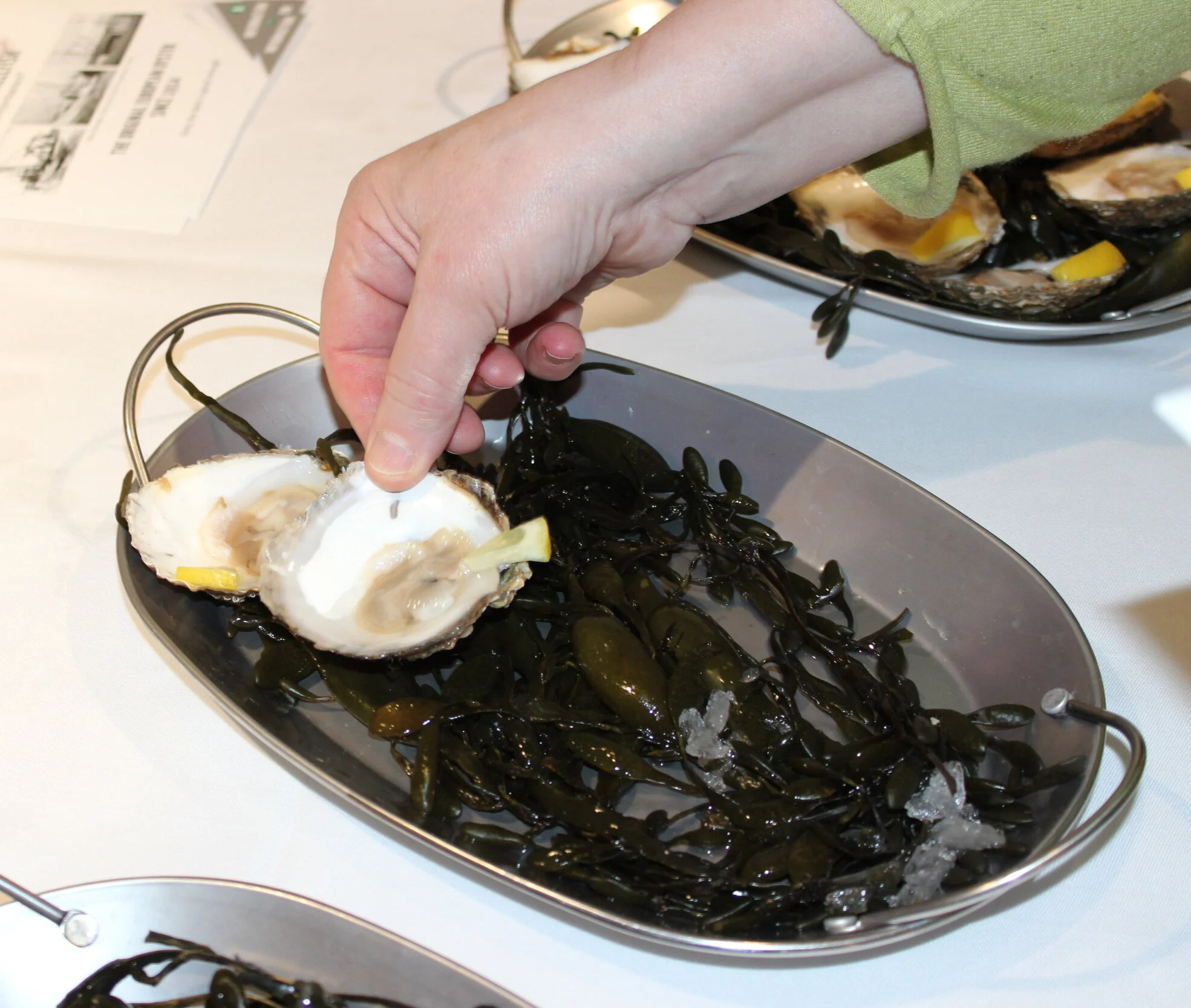Perfect match: the wild treasure, the cold wine
the water of the Limfjord meets the land of Champagne
Oysters and bubbles are a wellknown alliance to awaken your senses, and you are invited as well
Tekst: Solveig Tange, Foto: Anne-Mette Holm, Solveig Tange, Svend Bonde
We had never met before, when Svend Bondes oysters were casted in the supporting role, as we presented our latest plot-champagne in late February. But I already loved the parallel between Svend, who collects the wild oysters from the waters of the Limfjord in Northern Denmark, and us, who look after our vines in Champagne. Under the same sky, and as the weather pleases.
As he unwrapped some handfuls of seeweed from the Limfjord on ice, I realized that Svends oysters and our new champagne were going to be a match, planned somewhere close to the seventh heaven. Through the pruning all winter, I had collected branches myself from the vines in our Soulières-plot to decorate the room.
Maybe it looked like a random detail of the decoration. However, not to me: Two minds but a single thought as we both had the idea to carry a bit of the daily surroundings of our products with us to Copenhagen. The branches with their buds in wintry looks from which the grapes develop later, and the seaweed that fluttered in the salty waters next to the shellfish.
How can you bring your vineyard to Copenhagen? At Champagne Tange-Gérard, we have tried different variations. This time we brought branches from the plot, that also gave the grapes for the champagne.
Obviously, the branches and the seaweed are just the opening. This is about the partnership between oysters and champagne. It’s got to be close to the most sensuous match to be found. Let’s get the party going then.
The round treasure of the Limfjord
Oysters from the Limfjord have been on the local menu since the Stone Age. Nobody has ever found out how the people of the Ertebølle-civilization (4-5.000 years BC) managed to open the meal. One theory is that they threw the oysters into the fire, thus boiling the shellfish in its own sauce, directly in the shell. Svend brought his personal knife. He displays the open shells on a bed he has arranged with the bladder wrack beforehand. With a tiny piece of lemon for those of us who find the taste of the sea a bit too much on its own.
In France, you can find oysters of this European type as well. But the Belon-oysters are cultivated in the mouth of the river Belon in southern Brittany. The lively boys and girls of the Limfjord live a life of total freedom. They belong to the biggest natural population of indigenous European oysters.
In their early youth the little oysters attach themselves to the bottom of the fjord with a small foot. Then they’ll begin the creation of their hard shell, that grows a bit bigger each year. Their only activity is to filter the water of the fjord, which explains why the taste is closely related to the living place. The Limfjord has a big flow of rather cold water with a good combination of salt, minerals, algae and plankton. Et voilà, this is the recipe of great and very local taste.
“We have one of the best oysters in the world, but we don’t quite appreciate it in Denmark. I could sell them all to Spain, but I don’t want to. We ought to eat our oysters in Denmark again.”
Svend Bonde sails one of 35 boats that fish the wild treasure of the Limfjord. All sails are set to continue this business. The oyster fishing in the Limfjord is sustainable (MSC-certification), which means that not too many oysters are collected in order to avoid overfishing. Like this the population of oysters stays in balance.
The only part left is to tempt more Danes to try a nutritional and special kind of food, that has come to us all the way from the Stone Age menu to the most exclusive dinner tables in Denmark and abroad. Let’s welcome the oyster in our plates and palates, all of us who are eager for something different. Why not in the company of another friend of all our senses?
The cold wine of Champagne
Champagne is one of the most known wines in the world. The notion of champagne is even better known as the synonym of the great party, the biggest luxury, the most elitist and decadent elegance. Thankfully, we are many who have learnt that the bubbles from northern France are so much more and feel like exploring further.
The looks of the Chardonnay-grapes with morningdew as they still hung on to the vines in the plot of les Crochettes in Soulières. These grapes - and othes - are what you enjoy when you sip a glass of Sollissime.
At first, champagne came about as a defect from the production. The climate had cooled down and in the late 1600s early winters stopped the fermentation of the wine prematurely. It restarted during the following spring as it got warmer again. Technically this worked as a second fermentation which left the wine slightly bubbly. This was at first not appreciated by the customers. Luckily for the winegrowers in Champagne, some decades later the wine from Champagne got back in fashion because of its sparkle. Everything was turned upside down: From a production failure the bubbles were now sought after and became central in a production of the best sparkling wine in the world. This work became known as champagne, and it basically never ceased.
The cold climate of the Champagne region meant that the grapes matured for longer and still never made it to a complete maturity. This turned out to be just perfect when you make sparkling wine, blend of different grape varieties, plots and years to achieve the same taste year after year. Nowadays, the climate is warmer again. The grapes are harvested earlier and they contain more sugar than at any other time in the last three centuries. This makes it possible to elaborate a different type of champagne, made from grapes from few plots only. Which enables a micro domaine like Tange-Gérard to create its own champagnes.
This is the kind of bottle we want to meet the wild oyster. A champagne, that tastes its location and year, made with sustainable grapes, that have been dealt with carefully before, during and after the grape harvest.
“Our plot Chardonnay champagnes are the full reflection of our own terroir: this is what our land can give with the best consideration for nature and care. We aim at making them with simplicity to generate complexity and elegance.”
Alain Gérards Chardonnay champagnes are a great match for a fine tasting dish like oysters. These white grape champagnes demonstrate an ethereal elegance and a freshness due to the acidity. Champagne is still a rather cold climate after all. The bubbles are always up for party.
Send your senses off freewheeling
The joy of expectation begins with the pop that kickstarts any champagne party. It carries on as we fill up the glasses. Myriads of fine bubbles pushing from under, then rising to form a string of circular foam along the rim of the glass. Like this, we have already had sort of a taste with our eyes, when we finally get hold of the glass to let the ear enjoy the crystalline sound of bubbles, that burst against the surface. They tickle the nose, before it begins to separate scents of lemon from those of flowers or yellow fruits. But that’s it, we can’t hold it off much longer, can we?
We are so much in for a taste. The bubbles carry on. They play on our tongue and in our palate, and they push their way into our veins to forward their message to the superior layer about having a good time big time. The first sip is fresh in the mouth, then comes a powerful undertone to be followed by dry and preserved fruits and brioche with a mineral and long end. Perfect for the oysters of Svend.
They even arrive in their own plates, that we try to balance, maybe with a tiny piece of lemon and a last remnant of saltwater of the fjord, that still splashes a bit in the deep half of the shell, as we eat the oyster with our eyes. A challenge in itself.
Maybe we never ate something with our fingers apart from burgers. Maybe we never burnt our fingers as we raised something real warm to the mouth with our fingers. Maybe we never tried how the smallest of movements may actually tilt our point of balance just enough to leak some saltwater on our fingers. This makes the meal even more bodily. But it does not matter. There is neither fork nor knife. We slurp the oyster directly from the shell. Quite possibly sounds may be heard, sounds that we never hear normally. Even less from ourselves.
The slightly salty miracle of the Limfjord is fleshy and firmer than oysters from Britanny for instance. They have an intense and mineral taste, that may be somewhat sweet or nutty, depending on the season. This is like a bite of the sea. As if the sea, always liquid, had made this one the only exception and become solid in the shape of these very oysters.
I believe we are ready to enjoy another glass. And maybe our sixth sense is about to become operative by now?
Young branches can grow up to five centimetes per day in June when their growth is at its fastest. This is their dance in the summerwind of 2015 in the Belles Feuilles-plot in Soulières.
Meet your sixth sense
In Champagne, we are nowhere close to the plays of the waves and the glint of light.
Even the ground under the vineyards is a layer of limestone, made by the shells of microscopic organisms that lived in a prehistoric sea 70 million years ago. This is the famous layer of chalk, that works like a swamp under the vineyards and keeps temperature and moisture constant in the caves. It is hardly a coincidence if the bubbles and seafood are best friends.
Now it is a lot easier for us to send our champagne to the Oysterbar in Glyngøre than for Svend to ship his oysters to our farm in Champagne. That’s why the Oysterbar is the place to go – whether in Glyngøre or the mobile “on the road” model – to wake up all senses already this summer. Even the sixth sense, as you try the match of water and land.
We are looking so much forward go present the wonderful oysters of the Limfjord and our Sollissime champagne from 2015. Danish meet French, Limfjord matches Champagne, liquid and solid, sea and land. Solveig Tange, Svend Bonde and Alain Gérard








